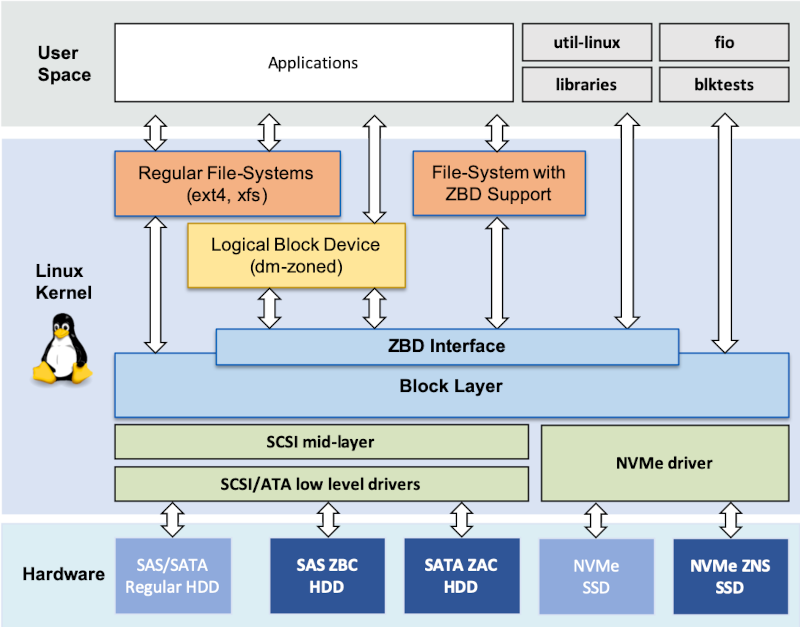Linux Zoned Storage Ecosystem
Zoned storage devices are not a plug-and-play replacement of traditional storage devices. This is due to the sequential write constraint imposed on zones: special software and drivers are required to ensure that applications comply with zoned-storage device constraints during operation.
Linux Kernel Zoned Storage Support
Support for zoned storage devices was added to the Linux® kernel with the release of version 4.10.0. This addition enabled support for zoned storage at different levels (the disk driver level, the file system level, and the device mapper driver level), and offered a range of options for supporting applications. This support is based on the Zoned Block Device (ZBD) abstraction.
A zoned block device is a generic representation of a zoned storage device, and is independent of the device access protocol and interface. This abstraction is the basis of Linux kernel support for zoned storage.
The interface associated with the ZBD device abstraction is an extension of the traditional Linux block device interface. The ZBD interface (with the help of device drivers) provides a generic zone-management interface to kernel subsystems (e.g. File systems) and to user applications that is compatible across all zoned device types and all access protocols.
A simplified view of the kernel structure, including the ZBD interface, is shown in the figure below.

The implementation of the Linux-ZBD interface provides functions for discovering the zone configuration of a given zoned device as well as functions for managing zones (for example, "zone reset"). Linux-kernel ZBD support also modifies the kernel block I/O stack to ensure that all device access constraints are met. These device access constraints include "zone spanning commands" and "sequential write ordering".
Developing for Zoned Storage
There are several ways to design a system application for zoned storage. The way that is right for you depends upon your system's structure and your ability to modify the application layer and your ability to choose a particular Linux kernel version.
-
Direct device management with passthrough commands
Users that own software applications and do not depend on the operating system and file system to control the device can directly use the device interface protocol to issue zone management commands by using a passthrough interface. In these cases, the applications must be rewritten with the new command sets and they must ensure that all data streams are sequential. The libzbc library provides functions to help with this approach.
-
Direct device management with block device file access
Managing zoned storage directly from the application layer is a valid approach but can be difficult to implement. This is true particularly in use cases where several device features must be combined (for example, when I/O priorities are used). Application level support can be simplified by relying on the kernel zoned block device support which allows accessing and managing zoned devices using regular POSIX system calls. While this does not remove the zoned device access constraints from the application scope, implementation of sequential write streams and zone management can be simplified. The libzbd library provides functions to help with this approach. Using the zonefs file system can also simplify application implementation.
-
Device mapper and POSIX file systems
If a user lacks software control at the application level but retains control over the choice of the version of the Linux kernel, more advanced kernel support features such as zoned block device compliant file systems (e.g. XFS and BTRFS) can be used to hide zoned storage access constraints from the application. Users may also rely on a device mapper driver that exposes zoned storage devices as regular block devices (for instance, the dm-zoned device mapper). If this solution is used, existing file systems can be used without any modification.
More information on the features provided by the Linux kernel for different versions can be found here.
To get started with zoned storage, see the Getting Started section, which details the first steps necessary to set up and verify a system that uses SMR disks.
The Linux Distributions section provides information regarding the availability of the ZBD interface on various Linux distributions.
Open source tools and libraries that support zoned storage are documented in the Tools and Libraries section.